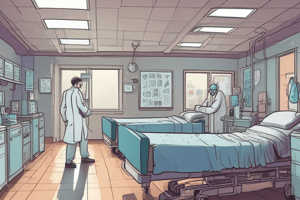Podcast
Questions and Answers
What is another term used to refer to Nosocomial infections?
What is another term used to refer to Nosocomial infections?
- Outpatient infections
- Health-care-associated infections (correct)
- Home-transmitted infections
- Community-acquired infections
When does a nosocomial infection typically develop after admission to a health-care facility?
When does a nosocomial infection typically develop after admission to a health-care facility?
- Within 48 hours (correct)
- Within 24 hours
- Within 72 hours
- Within 12 hours
Which mode of transmission is most commonly associated with Nosocomial infections?
Which mode of transmission is most commonly associated with Nosocomial infections?
- Contact transmission (correct)
- Respiratory route transmission
- Food borne transmission
- Vector transmission
In the context of Nosocomial infections, what does 'Blood borne' transmission refer to?
In the context of Nosocomial infections, what does 'Blood borne' transmission refer to?
How do nosocomial infections differ from community-acquired infections?
How do nosocomial infections differ from community-acquired infections?
Which type of contact transmission involves direct physical contact?
Which type of contact transmission involves direct physical contact?
Which mode of transmission is specifically mentioned for nosocomial infections?
Which mode of transmission is specifically mentioned for nosocomial infections?
What is the primary mode of contact transmission for nosocomial infections?
What is the primary mode of contact transmission for nosocomial infections?
Which of the following is NOT a mode of transmission for nosocomial infections as per the text?
Which of the following is NOT a mode of transmission for nosocomial infections as per the text?
In the context of nosocomial infections, what type of indirect transmission is highlighted?
In the context of nosocomial infections, what type of indirect transmission is highlighted?
Flashcards
Nosocomial infections
Nosocomial infections
Infections acquired in a healthcare setting.
Health-care-associated infections
Health-care-associated infections
A synonym for nosocomial infections, emphasizing their origin in healthcare settings.
When do nosocomial infections develop?
When do nosocomial infections develop?
Nosocomial infections typically manifest within 48 hours of admission to a healthcare facility.
Contact transmission
Contact transmission
Signup and view all the flashcards
Blood-borne transmission
Blood-borne transmission
Signup and view all the flashcards
Touch transmission
Touch transmission
Signup and view all the flashcards
Respiratory route transmission
Respiratory route transmission
Signup and view all the flashcards
Primary mode of contact transmission
Primary mode of contact transmission
Signup and view all the flashcards
Which mode of transmission is NOT common for nosocomial infections?
Which mode of transmission is NOT common for nosocomial infections?
Signup and view all the flashcards
Indirect transmission through instruments and needles
Indirect transmission through instruments and needles
Signup and view all the flashcards
Study Notes
Nosocomial Infections
- Also known as health-care-associated (HAIs) or hospital-acquired infections
- Infectious diseases acquired in a health-care facility, specifically in hospitals
- Must develop at least 48 hours after admission
Mode of Transmission of HAIs
- Contact transmission:
- Direct physical contact through touch (e.g., Staphylococcus, HSV)
- Indirect contact through contaminated objects (e.g., instruments, needles, or dressings)
- Respiratory route:
- Airborne aerosols
- Inhalation of droplets or aerosol from respiratory tract secretions (e.g., sneezing, coughing, speaking)
- Food borne:
- Ingestion of contaminated food, water, or drinks
- Vector transmission:
- Through insect bites
- Blood borne:
- Through medical procedures (e.g., Dialysis, Transfusions, Heart Surgery, Injections, Catheterization)
Studying That Suits You
Use AI to generate personalized quizzes and flashcards to suit your learning preferences.




